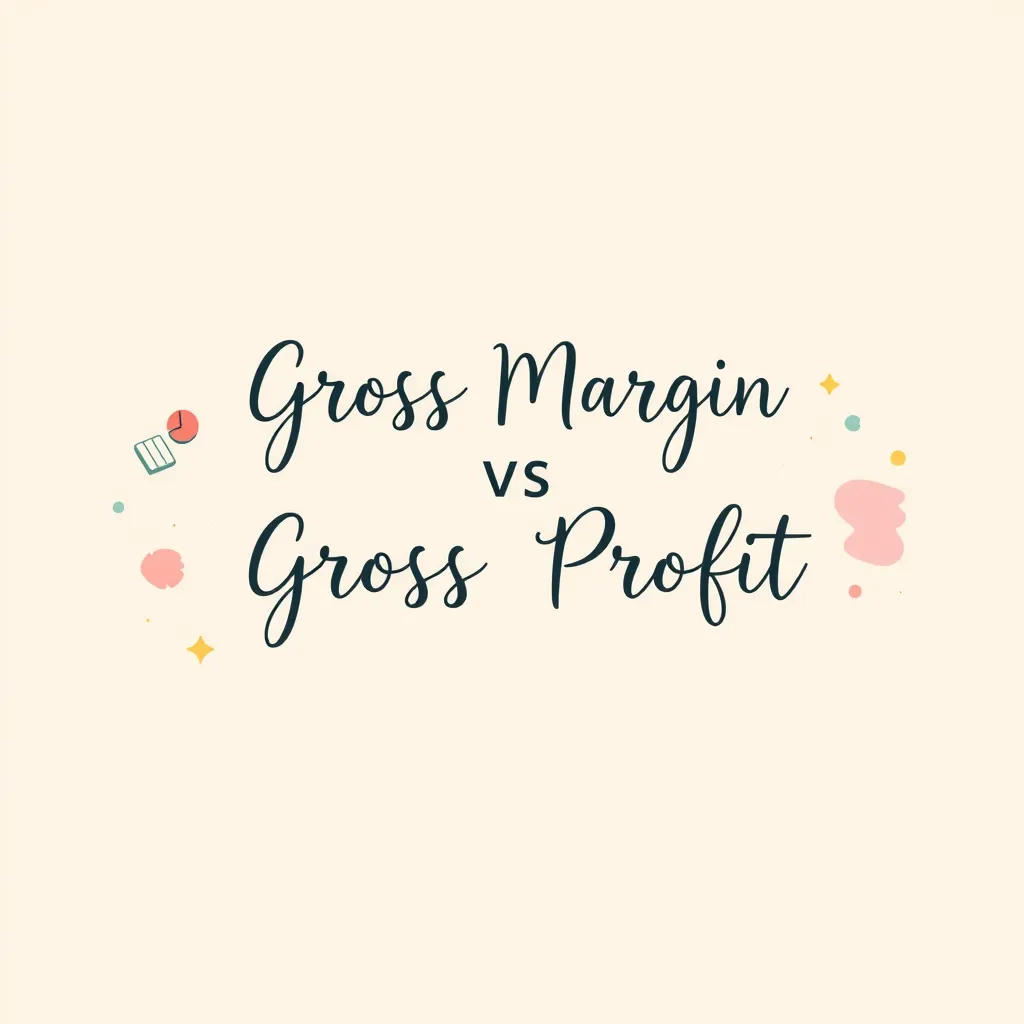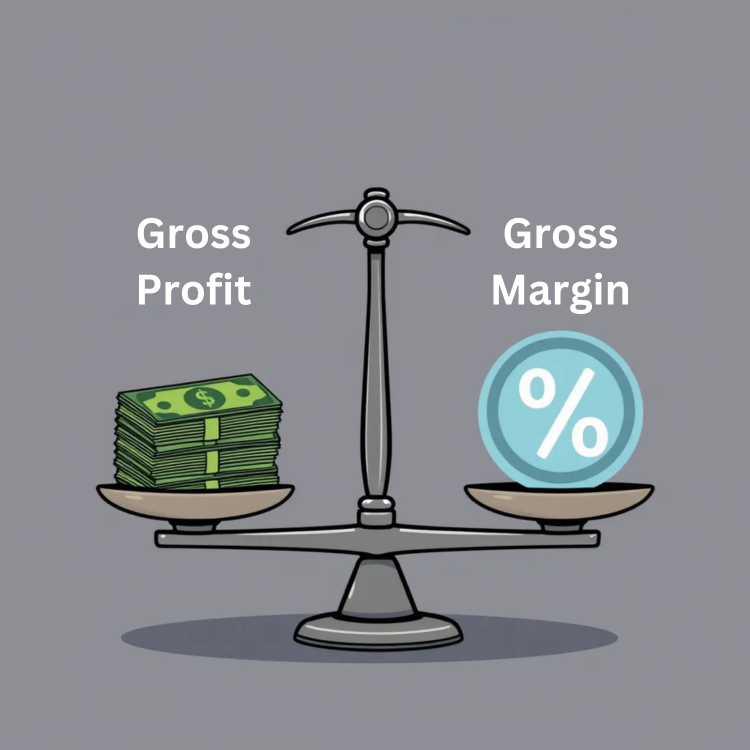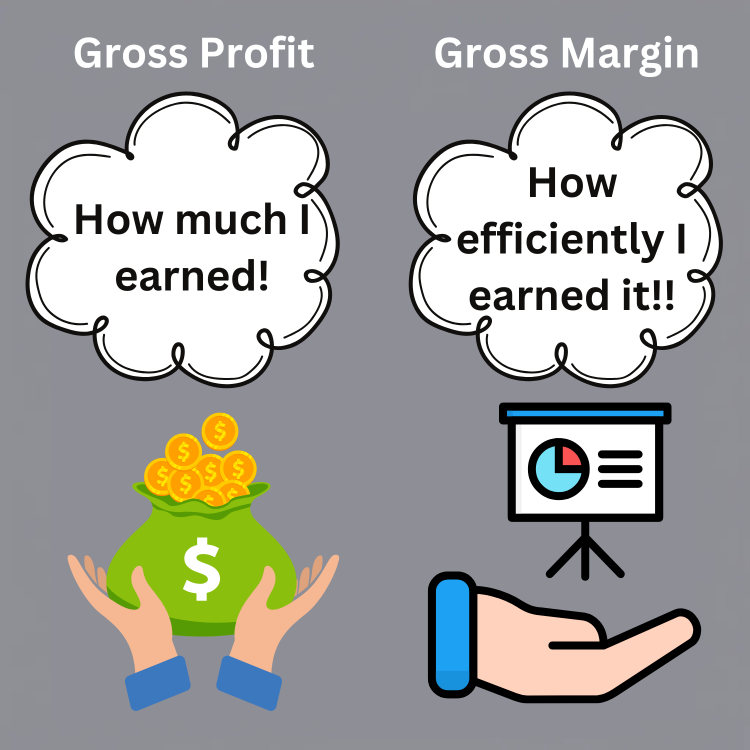Gross Margin vs Gross Profit: Understanding the Key Differences [2024]
Gross Margin vs Gross Profit: Master the Metrics That Drive Your Business Profitability
Gross Margin vs Gross Profit: Master the Metrics That Drive Your Business Profitability

When evaluating the financial health of a business, terms like gross margin and gross profit often surface in discussions. These metrics are fundamental in understanding a company’s ability to generate income relative to its expenses. However, they are not the same, and misinterpreting their differences can lead to flawed business decisions.
Understanding these metrics and how they differ equips businesses to analyze profitability accurately and make informed decisions to optimize financial outcomes.
Quick Insight: Gross profit tells you the “what” in terms of earnings, while gross margin explains the “how well” in terms of efficiency.

Gross profit is a fundamental financial metric that indicates the dollar value a business retains after subtracting the cost of goods sold (COGS) from its total revenue. It reflects the raw earning power of a business before accounting for other operational expenses, such as rent, marketing, and administrative costs.
Formula:
Gross Profit = Revenue − COGS
Gross profit is a direct indicator of how effectively a company is managing its production costs relative to its revenue. High gross profit suggests efficient cost management or strong sales performance, whereas low gross profit can signal inefficiencies or pricing challenges.
Imagine a small business selling handmade furniture:
Gross Profit = 50,000 − 30,000 = 20,000
This means the business retains $20,000 from sales to cover additional expenses like rent, salaries, and marketing.
Key Takeaway: Gross profit provides a snapshot of profitability but doesn’t account for other operating or administrative expenses. It’s a starting point for understanding overall financial health.
Gross margin is a percentage-based metric that expresses gross profit relative to total revenue. It demonstrates how efficiently a business is managing its costs to generate revenue. Unlike gross profit, which provides an absolute dollar amount, gross margin gives insight into profitability as a ratio, making it useful for comparisons across time periods, products, or industries.
Formula:
Gross Margin (%) = (Gross Profit / Revenue) × 100
Gross margin is a critical indicator of operational efficiency. A higher gross margin implies that a business retains more revenue after covering COGS, leaving more room for operating expenses and profits. It’s especially useful for benchmarking against competitors or tracking performance trends over time.
Using the same example as before:
Gross Margin (%) = (20,000 / 50,000) × 100 = 40%
This means that for every dollar earned in sales, the business retains 40 cents after covering COGS.
Key Takeaway: While gross profit focuses on the raw dollar value of earnings, gross margin highlights the efficiency of those earnings as a percentage of revenue. It’s particularly valuable for strategic decision-making and competitive analysis.

Gross margin and gross profit are closely related but serve distinct purposes in financial analysis. While both metrics originate from the same data—revenue and cost of goods sold (COGS)—their interpretations and applications differ significantly. Understanding these differences is essential for making informed decisions about pricing, cost management, and overall business strategy.
| Aspect | Gross Profit | Gross Margin |
|---|---|---|
| Definition | The dollar amount remaining after subtracting COGS from revenue. | The percentage of revenue retained after covering COGS. |
| Formula | Revenue - COGS | (Gross Profit ÷ Revenue) × 100 |
| Metric Type | Absolute value (dollars). | Relative value (percentage). |
| Use Cases | Evaluating overall profitability in monetary terms. | Comparing operational efficiency and cost management across products or periods. |
| Focus | “How much” a business earns above COGS. | “How efficiently” a business generates earnings above COGS. |
Using the earlier example:
Gross Profit tells us that the business has $20,000 left after covering production costs.
Gross Margin reveals that 40% of the revenue is retained as gross profit, offering a clearer view of efficiency.
Key Takeaway: Gross profit provides the “what,” while gross margin explains the “how well.” Use gross profit for absolute evaluations and gross margin for relative performance analysis.
While gross profit and gross margin focus on a business’s revenue after covering the cost of goods sold (COGS), net profit and net profit margin take the analysis a step further by accounting for all other expenses. These include operating costs, taxes, interest, and other financial obligations.
Net Profit: The total profit left after deducting all expenses from revenue, including operating costs, interest, and taxes.
Net Profit = Gross Profit − Operating Expenses − Taxes − Interest
Net Profit Margin: The percentage of revenue that remains as net profit after all expenses.
Net Profit Margin (%) = (Net Profit / Revenue) × 100
| Aspect | Gross Profit/Margin | Net Profit/Margin |
|---|---|---|
| Definition | Focuses on revenue after covering COGS. | Accounts for all expenses beyond COGS. |
| Scope | Limited to production and direct costs. | Comprehensive view of overall profitability. |
| Use Cases | Evaluating operational efficiency. | Assessing total financial health. |
Using the same example:
Net Profit:
Net Profit = 20,000 − 10,000 − 2,000 = 8,000
Net Profit Margin:
Net Profit Margin (%) = (8,000 / 50,000) × 100 = 16%
This means the business retains 16 cents in profit for every dollar of revenue, after accounting for all costs.
Key Takeaway: Gross metrics highlight operational efficiency, while net metrics provide a full picture of financial health.
Gross margin and gross profit are powerful metrics that provide different perspectives on a business’s financial performance. When used together, they offer actionable insights to guide strategic decisions and optimize profitability.
Example Decision: A bakery notices declining gross profit due to rising flour costs. By increasing the gross margin (adjusting prices or sourcing cheaper ingredients), they can stabilize profitability.
Example Decision: A clothing retailer discovers that premium jackets have a 60% gross margin, while budget t-shirts have only 20%. The retailer might prioritize promoting jackets or reevaluate pricing for t-shirts.
Example Decision: An electronics manufacturer sees varying gross margins between product categories. By renegotiating supplier contracts for low-margin products, they improve overall efficiency.
Example Decision: A SaaS company learns that its gross margin is 55%, while competitors average 70%. By automating certain processes and adjusting pricing, they aim to close the gap.
Example Decision: An eCommerce store identifies that a particular category, with a 50% gross margin, drives the bulk of its profits. It invests more in advertising and inventory for that category.
Example Decision: A startup with stable gross margins expands into a new region, confident that its current cost structure supports scaling.
Key Takeaway: Gross profit tells you how much money your business generates, while gross margin reveals how efficiently it generates that money. Together, they provide a roadmap for making informed, strategic decisions. Read our article on Top Ecommerce Metrics for more information.

Despite being fundamental financial metrics, gross margin and gross profit are often misunderstood. These misconceptions can lead to misinformed business decisions, inefficiencies, and missed opportunities.
Example: A company with $200,000 gross profit on $1,000,000 revenue has a gross margin of 20%. Knowing both metrics helps contextualize profitability in terms of scale and efficiency.
Example: A manufacturing company with $500,000 gross profit and $600,000 operating expenses would be operating at a loss, despite a healthy gross profit figure.
Example: A local bakery uses gross margin to analyze ingredient costs and adjust product prices, ensuring profitability on every sale.
Example: A tech company slashes production costs to boost gross margin but faces customer backlash due to lower product quality, ultimately harming revenue.
Example: A retailer has a gross margin of 60%, but high rent and marketing expenses reduce net profit to just 5%. Solely focusing on gross margin would mask the underlying challenges.
Example: A sales team uses gross margin data to tailor pricing strategies, while an operations team uses gross profit insights to manage production costs.
Key Takeaway: Understanding the distinctions and limitations of gross profit and gross margin ensures accurate analysis and better decision-making. Avoiding these misconceptions allows businesses to leverage these metrics effectively.
No, gross margin and gross profit are different. Gross profit is the dollar amount remaining after subtracting the cost of goods sold (COGS) from revenue, while gross margin is that amount expressed as a percentage of revenue.
Both are important but serve different purposes:
Gross margin focuses on revenue after covering COGS, while net margin accounts for all expenses, including operating costs, taxes, and interest. Net margin reflects the overall profitability of a business.
Generally, yes, as it indicates better efficiency in managing costs relative to revenue. However, excessively cutting costs to boost gross margin can harm product quality or customer satisfaction, so balance is key.
Yes, a business with high gross profit can still have low net profit if operating expenses, taxes, or other costs are too high. For example, a business with $100,000 in gross profit but $95,000 in expenses would only have $5,000 in net profit.
Gross margin helps businesses evaluate how pricing impacts profitability. It ensures that products are priced to cover costs while maintaining a healthy profit percentage.
Industries like software, pharmaceuticals, and luxury goods often have high gross margins due to lower production costs or premium pricing. However, industries with high COGS, such as manufacturing or retail, typically have lower margins.
Gross profit and gross margin are essential metrics for understanding and improving a business’s financial performance. While gross profit shows the dollar value earned above COGS, gross margin reveals the efficiency of those earnings as a percentage. Together, they provide actionable insights into profitability, pricing, and operational efficiency. By regularly analyzing these metrics, businesses can make smarter decisions, optimize costs, and drive sustainable growth.
Ready to simplify financial tracking and boost your operational efficiency? Sign up for OneCart today to streamline inventory, pricing, and profitability management—all in one intuitive platform. Try it free!
Automate & Scale Your Online Business with OneCart
Start a Free TrialUsed by hundreds of merchants in Singapore & Southeast Asia